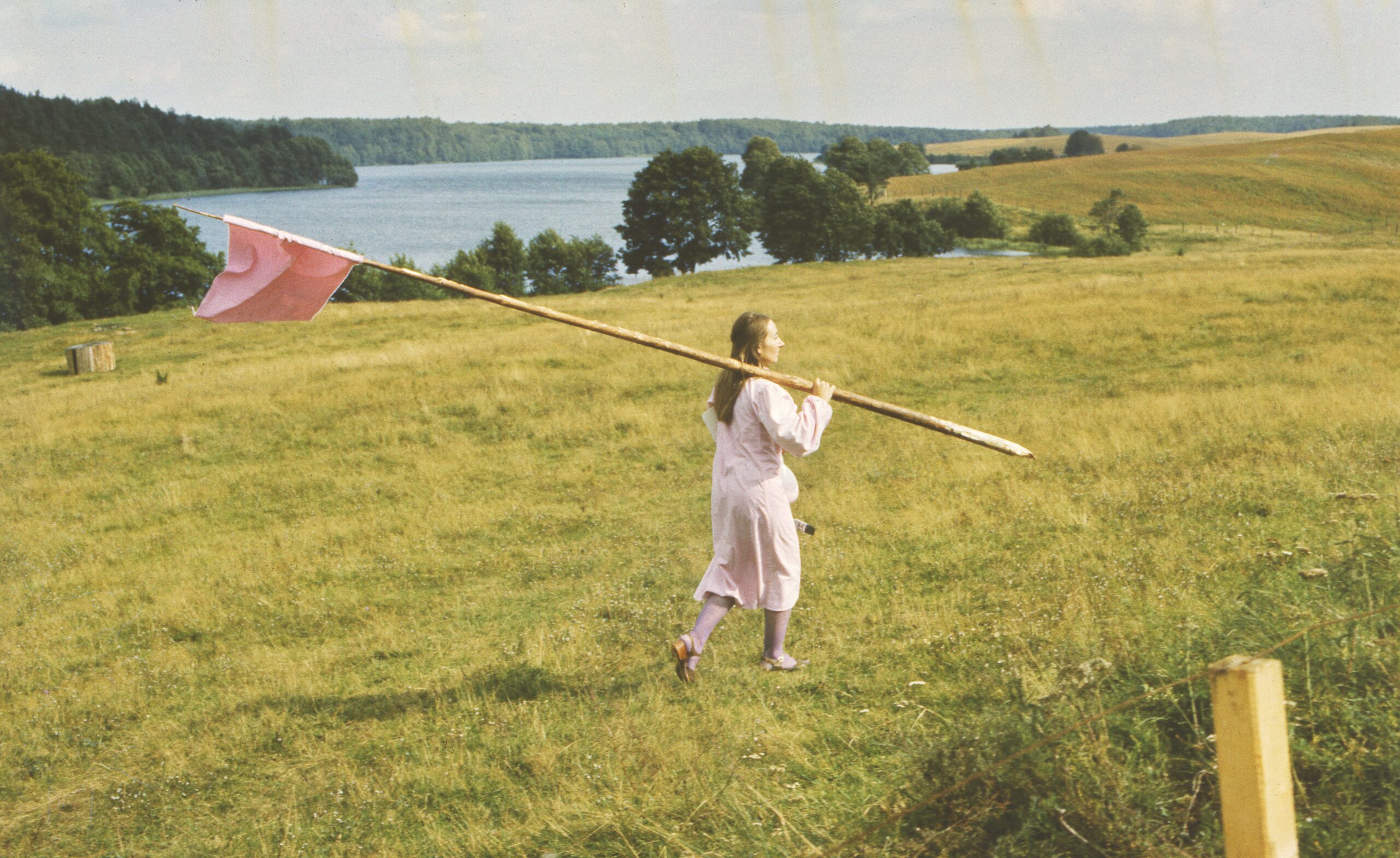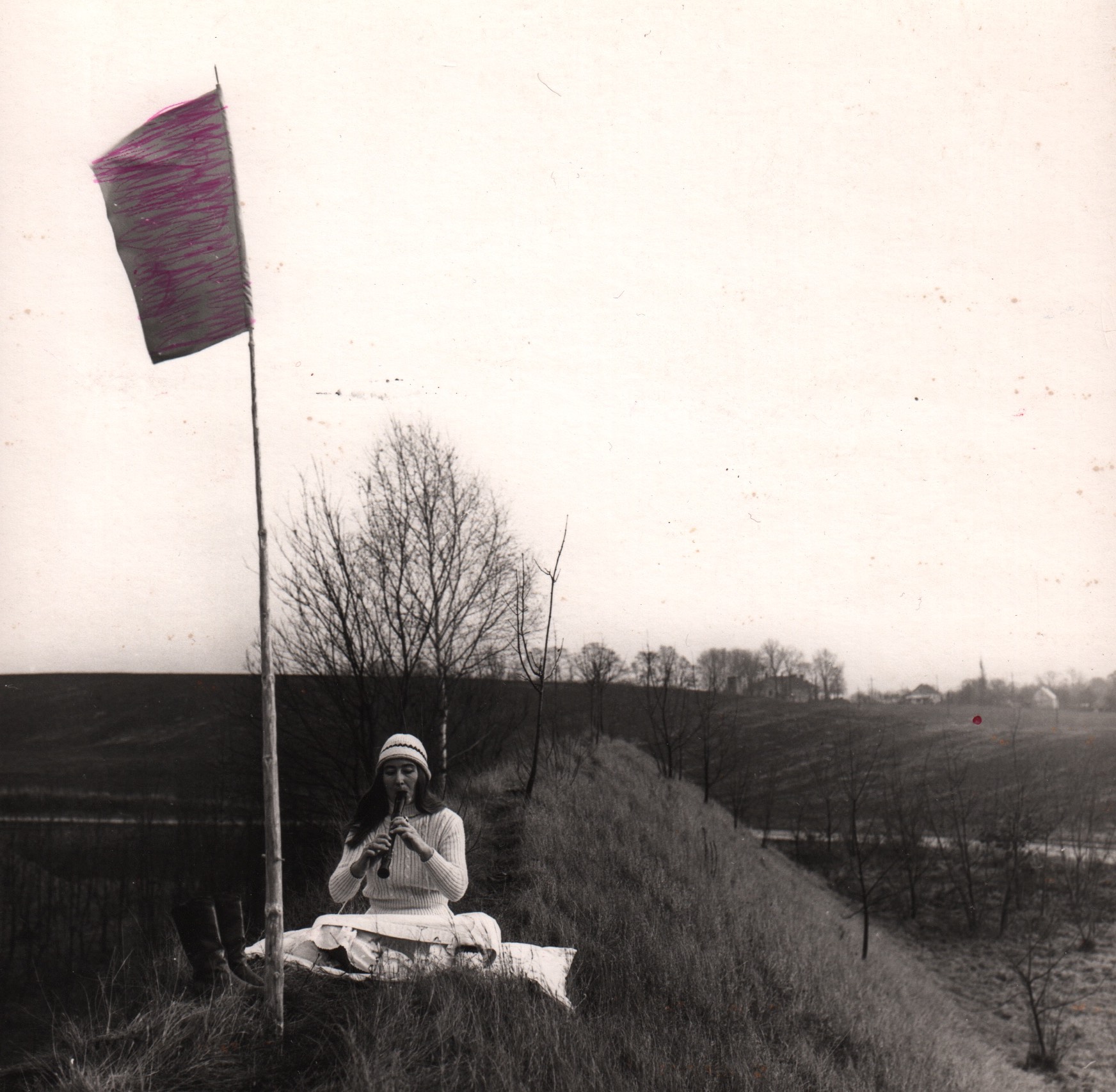Maria Pinińska-Bereś
Maria Pinińska-Bereś was born in 1931. She graduated in 1956 from the sculpture studio of Xawery Dunikowski at the Academy of Fine Arts in Kraków. She was a member of the Kraków Group since 1979. In 1983 she participated in the 17th São Paulo Art Biennial.
Initial figurative works were largely influenced by Professor Dunikowski, but some signs of the artist’s individual style could also be observed back then. The Birth sculpture from 1958 was the first one to feature pink color which was so characteristic of later works of the artist.
In the early nineteen sixties, Pinińska-Bereś started leaning toward more abstract forms. The Rotunda cycle includes heavy concrete figures referring to Roman architecture but placed on soft based made of fabrics, which were soon to become one of the key materials used by the sculptor.
At the same time, Lady with a Bird coming from 1960 fully reveals the artist’s interest in the female figure as the main topic of her works. In spite of the fact that Pinińska-Bereś kept her distance from feminist art, she is considered one of the key precursors and representatives of this trend in Poland. Between 1966 and 1967 the artist used paper-mâché to prepare Corsets referring to the image of a woman reflecting male desires
The Psycho-furniture cycle, which the artist started creating in 1968, is the criticism of women’s social roles, treated with a great deal of irony, but at the same with loads of tenderness, but also a hint of eroticism.
Around mid-nineteen seventies Pinińska-Bereś focused on soft, oval, and delicate forms which were so very characteristic of her output at later stages. She used a sponge trimmed with a fabric, quilted materials, cushions, the ‘feminine’ delicacy of which was stressed by pink and white coloring.
They are complemented with poetic titles that make an integral part of each sculpture, e.g. A Cruise Across the Seas and Oceans Around the Table, Leda’s Toilet, Smudged with the Sky, Transition through the Duvet.
In 1971 the artist commenced another cycle entitled Egzystencjaria, which was a very personal comment on love and motherhood, but also aggression. Starting from the mid-nineteen eighties Pinińska-Bereś also engaged in a very original dialogue with the history of art. She created works inspired by such masterpieces as King and Queen by Henry Moore, The Burning Giraffe by Salvador Dali, or The Infantas by Velazquez.
Along with her assemblage sculptures, she also organized small-scale outdoor performances (Kite letter, Author’s Banner) and gallery events (Laundry I, Nothing but the Broom, A woman with a Ladder, Activities for Kitchen Utensils).
The artist died during the preparation for her retrospective exhibition in 1999 (GSW Bunkier Sztuki in Kraków, Galeria Bielska in Bielsko-Biała, Galeria Miejska Arsenał in Poznań).
Pinińska-Bereś’s works are in the collection of National Museums in Kraków, Wrocław, Poznań, Warsaw, the Silesian Museum in Katowice, Art Museum in Łódź, Zachęta in Warsaw, Polish Sculpture Centre in Orońsko, Bochum Museum, and are owned by private art collectors. Two works by Maria Pinińska-Bereś were included in The World Goes Pop exhibition in Tate Modern in London (2015/2016).
Selected solo exhibitions:
2019
Living Pink, The Approach Gallery, London, UK
2017
Trace of a Woman, BWA Gallery of Art, Olsztyn, PL
The Performer, Galeria Monopol, Warsaw, PL
2014
Maria Pinińska-Bereś and Jerzy Bereś, Galeria Monopol, Warsaw, PL
2013
Maria Pinińska-Bereś: Drawings, David Radziszewski Gallery, Warsaw, PL
2012
Imaginarium of Corporeality – Maria Pinińska-Bereś, State Gallery of Art, Sopot, PL
2011
Maria Pinińska-Bereś, Galeria Piekary, Poznań, PL
2007
Mobile-Immobile – Records of Maria Pinińska-Bereś’s Performances, Bunkier Sztuki, Krakow, PL
2001
Maria Pinińska-Bereś 1931–1999, Baltic Gallery of Contemporary Art, Słupsk, PL
1999–2000
Maria Pinińska-Bereś 1931–1999, Bunkier Sztuki Gallery of Contemporary Art in Kraków; Galeria Bielska BWA in Bielsko-Biała; Arsenal Municipal Gallery in Poznań; BWA Awangarda Gallery in Wrocław, PL
1997
Maria Pinińska-Bereś. egzystentialium, Studio Gallery, Warsaw, PL
1996
Maria Pinińska-Bereś. Sculptures, Manhattan Gallery, Łódź, PL
1993
Maria Pinińska-Bereś, Centre of Polish Sculpture, Orońsko, PL
1992
Maria Pinińska-Bereś, Starmach Gallery, Kraków, PL
Maria Pinińska-Bereś. Sculptures, BWA, Sandomierz, PL
Maria Pinińska-Bereś,BWA, Pomeranian Dukes Castle, Szczecin, PL
1991
Maria Pinińska-Bereś, BWA, Koszalin, PL
1990
Maria Pinińska-Bereś. Works from the 1960s, Krzysztofory Gallery, Krakow, PL
1988
Maria Pinińska-Bereś. Works from the 1980s, Krzysztofory Gallery, Kraków, PL
Maria Pinińska-Bereś, Gallery 72, District Museum, Chełm, PL
1982
Maria Pinińska-Bereś, BWA, Lublin, PL
1980
Maria Pinińska-Bereś. Sculptures, Rytm Gallery, Kraków, PL
Maria Pinińska-Bereś, Krzysztofory Gallery, Kraków, PL
1976
Maria Pinińska-Bereś, Ryszard Kwiecień, Antoni Porczak, Labirynt Gallery, Lublin, PL
1973
Maria Pinińska-Bereś, Współczesna Gallery, Warsaw, PL
1970
Maria Pinińska-Bereś, Piwnica pod Baranami, Kraków, PL
Selected group exhibitions:
2024
The Plastic Body. Sculpture from Poland 1960-1989, Stavanger Art Museum, Norway, NO
The absolute elimination of sculpture. Polish sculpture of the first half of the 1970s, Center of Polish Sculpture in Orońsko, PL
Women’s Art II, Ujazdowski Castle Center for Contemporary Art, Warsaw, PL
Material Memories, Collection Migros Museum für Gegenwartskunst, Migros Museum, Zürich, CH
Some people are like hills. Starak Collection – an exhibition celebrating the 10th anniversary of Spectra Art Space, Starak Foundation, Warsaw, PL
Multiple Realities: Experimental Art in the Eastern Bloc, 1960s–1980s, Phoenix Art Museum, US
Multiple Realities: Experimental Art in the Eastern Bloc, 1960s–1980s, Vancouver Art Gallery, CA
2023
The art of seeing. Nowosielski and others, Royal Castle in Warsaw, PL
Opening. Koszalin open-air workshops in Osieki 1963-1981, District Muzeum, Koszalin, PL
Multiple Realities: Experimental Art in the Eastern Bloc, 1960s–1980s, Walker Art Center, Minneapolis, US
Cooking Cleaning Caring: Care Work in the Arts since 1960, Josef Albers Museum, Bottrop, DE
Rococo madness! Fascination with Rococo in Silesia (18th–21st centuries), National Museum in Wrocław, PL
Let them sew! Contemporary Polish sewn sculpture, Center for Contemporary Art “Signs of the Times”, Toruń, PL
Artists from Krakow. II Grupa Krakowska, MOCAK Museum of Contemporary Art, Cracow, PL
2022
Let Them Weave!, Contemporary Polish Sewn Sculpture, Orońsko, PL
Beyond Eden, Muzeum Ślaskie, Katowice, PL
MAŁGORZATA MARKIEWICZ. A MAN’S WORLD NO MORE, Bunkier Sztuki Gallery of Contemporary Art, Kraków, PL
CLICK. Sexualisation of Food in Art, Arton Foundation, Warsaw, PL
2020
Soap Bubbles, Contemporary Art Gallery in Opole, PL
The Penumbral Age. Art in the Time of Planetary Change, Museum of Modern Art in Warsaw, PL
Female Reservoir, The Academy of Fine Arts, Kraków, PL
2019
SHAPESHIFTERS – Sascha Braunig, Sandra Mujinga, Maria Pinińska-Bereś, The Approach Gallery, London, UK
11/944 from the Collection of Galeria Labirynt, Galeria Labirynt, Lublin, PL
Oversupply. On early environmental and land (post)artistic practices in Poland, Contemporary Art Gallery, Opole, PL
2018
The Power of Nature. Henry Moore in Poland, Centre of Polish Sculpture, Orońsko, PL
2017
56 Artillery Lane, Raven Row Gallery, London, UK
Lady in the Mirror. Female Art Strategies in the 1970, Galeria Piekary, Poznań, PL
A-geometry. Hans Arp and Poland, National Museum, Poznań, PL
2016
All Mounds Can Be Seen From My Window, Bunkier Sztuki Gallery of Contemporary Art
Modern and contemporary art from Poland, Museum Jerke, Recklinghausen, DE
20 – An Exhibition In Three Acts: Collection Revisited 1960–1982, Migros Museum of Contemporary Art, Zürich, CH
2015
The World Goes Pop, TATE Modern, London, UK
(Don’t) Touch! Haptic Aspects of Polish Art After 1945, Centre of Contemporary Art “Znaki Czasu” in Toruń, PL
Gender in Art, MOCAK Museum of Contemporary Art, Cracow, PL
2011
Three Women. Maria Pinińska-Bereś, Natalia Lach- Lachowicz, Ewa Partum , “Zachęta” National Gallery of Art, Warsaw, PL
2010
In the Circle of Master Xawery. Dunikowski and his Pupils, The Xawery Dunikowski Museum of Sculpture, National Museum, Warsaw, PL
Gender Check, Femininity and Masculinity in Art of Eastern Europe, MUMOK, Vienna, AU
2009
Difference Beyond Difference, Słodownia, Stary Browar, Poznań, PL
2008
Revolutions 1968, Zachęta – National Gallery of Art, Warsaw, PL
1998
Blask, Galeria Sztuki Współczesnej Domu Krakowskiego, Nürnberg, DE
Polish Culture Institute, Berlin, Germany
Chodzac po ziemi, Musée d’Historie Vivante, Montreuil, FR
Perz-Rhizom, Galeria Pryzmat, Kraków, PL
1997
Starmach Gallery
1996
Art in Poland: New Directions, University at Buffalo Art Gallery, US
Salon malarstwa i rzeźby, Pałac Sztuki TPSP, Kraków, PL
Impact, avant-garde cracovienne après 1945, Polish Institute, Paris, FR
Kobieta o kobiecie, BWA, Bielsko-Biała, PL
1995
6th international drawing triennial in Wrocław – art as thought, art as energy, BWA ‘Awangarda’, Wrocław, PL
Artyści polscy na festivalach międzynarodowych (Polish artists at international festivals) 1975–1995, Muzeum Narodowe, Wrocław, PL
Wystawa Grupy Krakowskiej, Galeria Krzysztofory, Wrocław, PL
X Międzynarodowe Spotkania Krakowskie, BWA, Kraków, PL
Poznańskie seminarium feministyczne. Pokazy artystyczne, Galeria Fractale, Poznań, PL
1994
Hautevolée, Galerie Rähnitzgasse, Dresden, DE
Ars Erotica, National Museum, Warsaw, PL
Grupa Krakowska 1932–1994, Zachęta National Gallery of Contemporary Art, Warsaw, PL





